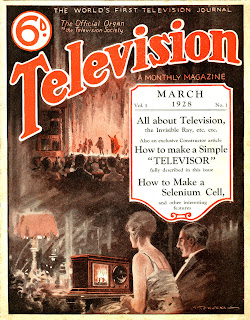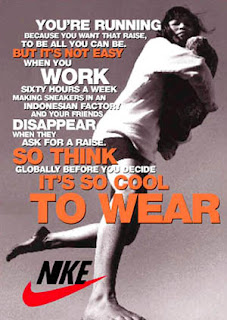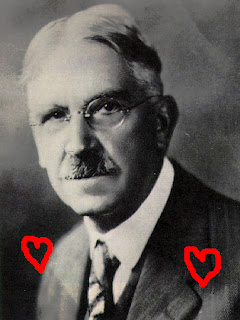Frank, T. (1997). The conquest of cool: Business culture, counterculture, and the rise of hip consumerism. Chicago: University of Chicago Press.
Providing a good overview of the interplay between big businesses and counter cultural groups, Frank describes how corporate cultures adopt or co-opt the tactics of counter cultural groups. The book makes the assertion that oftentimes resistance and "revolution" came from within the corporations themselves, counter to the conventional notions of rebels originating outside the system. Though somewhat dated, with an emphasis of marketing campaigns of the 1960s, it's easy to see parallels to practices today. I'm looking forward to reading Frank's One Market Under God, which should have more contemporary examples.
Frank, T. (2009). "The Tilting Yard: Dissent Commodified." Wall Street Journal - Eastern Edition, 254(42), A13.
While not a peer-reviewed article, I was searching for more current writing from Thomas Frank, whose Conquest of Cool I very much enjoyed, and came upon this brief article. In it, Frank successfully merges the ideas of Heath and Potter, who explain counter cultural groups as outgrowths of capitalism, with the notions of Klein, who bemoan society's lost of authenticity in its struggle for conformity. Frank's reflection aligns with what most people probably already believe: American culture is becoming increasingly inauthentic, and corporations aren't helping any.
Halnon, K. (2002). Poor chic: The rational consumption of poverty. Current Sociology, 50(4), 501.
Karen Halnon explores how some trends celebrate lower class living, what she calls "poor chic." She cites a host of examples in which companies have profited off of symbols of poverty, such as expensive hosiery that comes already torn or bowling shoes which cost more than one hundred dollars (502). These symbols can be viewed as distortions of reality in that they can be correlated with poverty (such as homelessness) but may also be "representations" without any basis in actuality. Consumers purchase "lifestyle symbols" as a way to identify themselves as cultural experts. Doing so also objectifies the lifestyle of poverty, making it distinctly separate and therefore safe from other class residents.
Halnon, K. (2005). Alienation incorporated: F*** the mainstream music in the mainstream. Current Sociology, 53(4), 441.
Similar to a previous article review I did of the same author, this article expands on the effect of shock music in youth culture. For youth who reject commercialism but are not willing to commit to a severely alternative lifestyle, high underground music offers a light way to engage in cultural resistance. According to Halnon, such artists as Eminem or Marilyn Manson offer youth a way to engage with authenticity. This music is also a way for businesses to commodify rebellion, though fans generally reject musical bands once they become commercialized and are promoted through avenues like MTV.
Halnon, K. (2005). Muscles, motorcycles, and tattoos: Gentrification in a new frontier. Journal of Consumer Culture, 6, 33.
Gentrification, the planned rehabilitation of lower class neighborhoods, can be considered a way for middle class residents to consider themselves "aesthetic consumers" of culture (36). However, Halnon rejects this lifestyle consumption theory, arguing instead that gentrification often serves as a way for people to fulfill personal needs. Similarly, people indulging in what she labels MMT's (muscles,
motorcycles, and tattoos) similarly experience a sort of gentrification. When middle or upper-middle class people begin adopting what used to be symbols of lower class livelihood, their motivations may be more sophisticated than the simple desire to seem like cultural savants.
Harold, C. (1999). Tracking heroin chic: The abject body reconfigures the rational argument. Argumentation and Advocacy, 36(2), 65.
While many decry the use of heroin chic as an unhealthy celebration of an alternative lifestyle, Christine Harold notes the trend's value in that it destabilizes standard norms of beauty. Portraying drugged-out models in dingy apartments serves as a cultural transgression, and in this sense heroin chic - even when it's published through mainstream businesses - serves as a way to get the audience to become more critical of the images they consume.
Harold, C. (2009). Ourspace: Resisting the Corporate Control of Culture. Minneapolis: University of Minnesota Press
This book provides a great overview of culture jamming and its various methods. Harold begins with an explanation of the Situationalist ideology, the resistance movement that originated in France in the early twentieth century and which was based on detournement. She then explores modern day examples of detournement through the use of parody in public spaces, anti-brands, and computer pranks. Through all these examples, Harold considers how artists manipulate messages to get audiences to critically evaluate the media usually consumed.
Heath, J., & Potter, A. (2006). The Rebel Sell: How the Counter Culture Became Consumer Culture. Capstone.
In contrast to Klein's belief that counter cultural groups serve as important sites of resistance (see No logo, below), Joseph Heath and Andrew Potter claim that so-called counter cultural movements are a natural outgrowth of capitalism. The driving force of capitalism is competition, and the popularity of anti-consumer products is a testament to their ability to define themselves as distinct and unique, not rebellious. The way people generally think about counter cultures, therefore, is all wrong. Rather than thinking about counter cultural groups as rebels against the corporate man, we should think of them as niches of the larger capitalistic system.
Klein, N. (2000). No logo: Taking aim at the brand bullies. Canada: Knopf.
In this book, Naomi Klein critiques the use of branding, arguing that while businesses once marketed products, they now market brands, or certain ways of life. She further explains how marketing strategies harm the individual citizen. Anti-consumerism groups and culture jamming, she says, play a valuable role in creating an informed individual and resisting the negative tides of commercialism.
Murphy, J. (2001). Mikhail Bakhtin and the rhetorical tradition. Quarterly Journal of Speech, 87(3), 259.
Useful for his introduction to Michail Bakhtin, Murphy explores the semantic implications of "rhetoric," concluding that although Mikhail Bakhtin denounced the use of rhetoric as a manipulative practice, rhetorical scholars can be informed by his claims within "Discourse in the Novel." The power of rhetoric, argues Murphy, lies in its ability to persuade and define situations. Rhetoric is a social process, and so issues of rhetorical tradition are ultimately valuable in that they actually offer a variety of viewpoints.
More Mass Info
Sunday, November 28, 2010
Tuesday, November 23, 2010
Lippman vs. Dewey
According to Lippmann, Americans don't have the capacity to understand the sophisticated, nuanced elements of their environments. They don't have enough time to study public affairs, they must contend with censorship, they have limited social contacts, they have preexisting bias to deal with, etc, etc. As such, they resort to simplistic "pictures in their heads," or stereotypes, to manage their worlds. Lippmann posits that the press often provides people with these pictures, and as such helps people navigate the relationships with their "unseen environment" (320).
Unfortunately, the press is not designed to provide Americans with accurate mental images. Like any other business, news agencies need revenues to stay afloat. To survive, they must cater to advertisers. They must attract and maintain readers to provide audiences for their audiences. And this is accomplished by standardizing issues or signaling events without explanation, not by offering truthful depictions of the world. As a result, publics are left largely uninformed. They can't seek out their own truthful information, and the press isn't giving it to them. Lippmann wonders if a public even exists, so woefully inadequate is the American ability to make sensible, unified decisions. He advocates for "intelligence agencies" instead, groups of scientific experts that advise the government. Democracy requires informed publics, and to save democracy the government must first rely on accurate information.
Dewey argues that a public does exist, it just happens to be a bit "bewildered." While he agrees with Lippmann that the American world is becoming increasingly complex, and that business interests do have the potential to manipulate the news, Dewey argued against the inability of American people to thoughtfully participate in their government. If they are not well-informed, it is because the media has yet to be reformed. Democracy by nature should be participatory, and a group of intellectuals that advise decision-makers smacks of elitism. What is the government made up of, if not its people? Dewey held hope that the media could be reformed to support the formation of well-reasoned public opinion.
Neither Lippman nor Dewey lived long enough to see how communication technologies have refined what the news is and how its effects are mediated. If they had, Lippman may have restored his faith in humanity and Dewey may have felt a bit smug. " To start, Lippmann's described constraints of time, social connections, and censorship have since been mitigated by the internet. While it previously took up a lot of time to research the intricacies of policy, computer users can now Google summaries of particular plans in a matter of seconds. While Lippmann's contemporaries may have lacked the social connections that kept them informed, current sites like Facebook and Linkedin.com ensure that people can reach out to those with particular knowledge and skill.
Finally, journalism is no longer limited to professionals working for big businesses. Any individual can format a blog in a matter of minutes, or post a comment to a corporate news story for all to see. Audiences are no longer the victim of standardized media messages, but are privy to a wide variety of sources and perspectives. Lippman feared the news would never be able to provide the "truths" necessary for democratic debate; now the public is inundated with a number of different truths. Those participating in public affairs have a myriad of sources of information, as well as thoughtful interpretation, at their disposal.
Both Dewey and Lippmann held that the purpose of the news was to inform the public. As it relates to democracy, they recognized that the news wasn't informing the public very well. Dewey held hope for reform; Lippmann didn't. But neither could anticipate the way news would change fundamentally. It is longer a unidirectional flow of information, but comprises all the different ways people send information to each other. If such a change can be considered "reform," then Dewey seems to have won the debate.
Sunday, November 7, 2010
72 hour television ban
 |
| Photo Credit: Early Visual Media Archeology |
I wasn't too worried about experiencing television withdrawal during last week's 72-hour-ban on moving pictures. Throughout the week my schedule doesn't allow for too much tv time. I already get my news from NPR each morning (I've got a pretty long commute) or I check the BBC website in between emails. So I wasn't feeling disoriented or out-of-touch, at least, not more than usual. I do watch television, but it's usually limited to Dr. Who marathons or Hulu broadcasts of Modern Family during the weekend. My husband watches practically no television, and my friends are all hippies who haven't had a television since they gave up meat in the 80s. Or they're self-proclaimed academics who hide their televisions behind tasteful antique armoirs when they're not watching C-SPAN. Either way, they claim they don't watch tv, and they certainly don't talk about watching tv. So I felt no pressure to watch myself during the past week.
I had more trouble avoiding YouTube videos. One classmate wanted to show me a clip about Miami during an evening course. Twice, my husband wanted to show me a guitar demo; I had to content myself with listening from the other side of his laptop. Even I thought I might want to check out a clip that demonstrates how a teacher might annotate a paragraph, which would have fallen under the purely-educational-and-therefore-exempted-from-the-ban category. The benefit of moving pictures is that you can see what's going on. While a page about how to code a passage might be useful, it can also be vague if the topic is unfamiliar. How helpful it would be, I thought, to see something in action. To see how a process is executed, and how the parts work in relation to each other. Ultimately, I couldn't find a clip about annotating texts, but it did contemplate for a moment about the utility of moving pictures.
Of course, I realize that a lot of moving images are also pretty useless. And it was also online where I noticed how advertisements, pretty devoid of substance unless you count the motive to get us to buy something, often straddle the line between moving pictures and still images. When visiting the IKEA website, for instance, I was met with swirling graphics as price values danced over pieces of furniture. Was this a "movie"? Should I avert my eyes? It only lasted for a few seconds before the photograph stilled, but it still made me feel guilty. I had a similar experience with an Expedia page. While I had expected to be bombarded with film images in my everyday surroundings, I'm not sure that prediction panned out. It was in my cyber-environments, instead, where I felt the sneaky movements of film media.
Now, I don't want to give the impression that the tv ban was wholly uneventful. It was a bit tricky on Friday evening, when my husband suggested we watch a movie that evening. I told him no, the 72 hours didn't end until midnight on Friday. Then I started making excuses: "Although, technically, I haven't been watching any television since Monday morning. So I've gone above and beyond the 72 hour limit. The point, after all, it to go a certain time frame without watching television."
"Nope," my husband countered. "Monday doesn't count because you had the option to watch television, if you wanted to. The point is that its absence should have an effect."
So we didn't go out to watch a movie. We went shopping instead. And yes, I realize that we essentially replaced one form of consumerism with another, more expensive, one. Which probably goes to show that I'm not being persuaded to buy things from television or movie messages. I didn't switch the kind of media I consume because I already spend hours online each day. And it's more likely that's the place I'm being influenced from.
Wednesday, October 27, 2010
Article Review
Karen Bettez Halnon’s “Inside Shock Music Carnival: Spectacle as Contest Terrain” was an interesting read. Throughout the course of the article, Halnon argues that shock music carnival bands exhibit a dis-alienating effect on their fans. That is, hardcore metal and punk bands don’t alienate youth, as scholars like Jeffrey Arnett (and most of the general public) claim. Rather, they create a place where the “otherness” of youth is protected and celebrated. Through the use of Mikhail Bakhtin’s “grotesque” imagery, Halnon explores how the concerts and songs of carnivalesque bands like Insane Clown Posse, Marilyn Manson, or GWAR serve as sites of resistance. Ultimately, these bands reject cultural forms of dominance, celebrate the authentic, and allow youth to feel as if they’re a part of something.
Halnon does a thorough job of providing an overview of the carnival and the grotesque. She starts with good ol’ Debord’s description of the “the society of the Spectacle,” claiming that we live in a world of nothingness. The Spectacle has limited the ability of consumers to think critically, and even dissatisfaction and dissent are commodities to be sold. (744) Halnon moves to an understanding of Bakhtin’s “carnival-grotesque”(747), which in its simplest form is understood as an “exaggeration of the improper.” Through disgusting or obscene acts, Bakhtin argued, the grotesque becomes a confusing place where traditional understandings about the world are challenged.
Halnon then provides many, many examples of rhetorical acts deemed “grotesque,” acts which originate from band members and from fans. She seems to take special delight in describing the (staged) decapitations of GWAR (771), the self-mutilation of Marilyn Manson (762), the violence of mosh pits (775), or the never-ending spray of spit, sweat, blood, and urine concert participants are subjected to (762-765). In sum, these transgressions of polite protocol celebrate “otherness” and serve as challenges to traditional American social structures.
They also represent a sort of grotesque realism. Everybody emits bodily fluids, everybody has violent fantasies. By emphasizing those primitive acts everyone has in common, shock carnival bands allow their fans a change to escape social hierarchies. They suggests a sort of authenticity not found and daily life, and offer spectators a place in their world. For a group of youth often characterized as black sheep or outsiders, this effect can be particularly therapeutic.
Looking at how carnival bands reject the signs of mainstream culture does help explain the appeal of shock-value bands. When situated within the context of counter cultures, the growing numbers of fans seems to make sense. Halnon has a firm grasp of a socio-cultural lens which gives value to a movement many others have dismissed.
However, the article can read like a work in progress, exhibiting issues of scope. Several times Halnon indirectly mentions her intention to write a book, and her two primary and interconnected arguments here – that bands have dis-alienating effects, and carnival bands serve as sites of cultural resistance – are large enough to each serve as an individual chapter. (Indeed, they are marked off as separate headings.) Toward the end of her argument, Holnan reaches outside the body of her evidence to discuss how the movie “Fight Club” contributes to her claims about the therapeutic effects of rage (776). Again, this inclusion is better suited as a separate book chapter, rather than firm support for her current debate.
Additionally, though she makes all-encompassing statements about sites of cultural resistance, it’s worth noting that metal fans are characteristically white, and they’re usually male. Halnon inserts an “intermission” into her text to briefly discuss the role of women in shock music carnival (772), but this serves more as a stylistic narrative than any attempt to consider the homogeneity of shock carnival music fans. The perspective changes as Halnon describes a first-hand experience observing a woman baring her chest to surrounding fans, and it appears Holnan is more interested in a personal aside than her argument at hand. It would have been more beneficial to flesh out how “commodification of dissent” (751) contributes to Ritzer’s notion of an “island of consumption”(745). Or how the grotesque acts in a space between conventional and chaotic worlds (she uses the phrase “liminal” a total of fourteen times). Halnon frames her article as a dialogue between the domination of the Spectacle and the resistant nature of the Spectacle, a sort of “contested terrain.” She provides much support for the later but only glosses over the former.
Friday, October 22, 2010
Cyberculture = Counterculture
The internet has become the primary domain for culture jamming. Master Chief's video provides a general survey of how people have used cheap software and internet traffic to provide their own sophisticated media critiques:
According to Fred Turner, associate professor in the Communication Department at Stanford University, technology is more than a domain where cultural resistance can occur. Cyberculture is a form of counterculture (Rothstein, 2006). And no, I don't mean cyberculture is a counterculture in the sense that computer geeks lack basic social skills and tend to reject mainstream hygiene habits. I mean that cyberculture represents a movement against preexisting social orders.
When looking at the role of technology, compared to the aims of countercultural groups, Turner's argument makes more sense. Computer and internet users are freed from hierarchial structures of traditional forms of media. They rely on horizontal networks, rather than top-down structures, to transmit information. As a result, the individual user becomes empowered by how skillfully he can navigate that network. A lone technician can topple the biggest and most powerful companies; The New York Times, the LA public transit system, CitiBank and NASA have all been hacked into.
Recognizing the power technology offers through it's ability to "foster[. . .] dissent and question[ . . ] authority" (Roszak, qtd. in Rothstein), a new degree of social activism has emerged: hactivism. Cited as a form of "electronic civil disobedience," hactivists take advantage of their technical skill to make soial commentary. The Yes Men create parody websites to highlight the hypocrisies of the big businesses, and offer software that allows others to create their own parody "mirror-sites." The Trojan Cow Project has widely posted illegal code for DVD gaming technology. Hactivist groups use the unique nature of interet technology, namely, that
Of course, you need not know a great deal about computer programming to use media technology to make a statement. Even a simple blog post can get your message across:
According to Fred Turner, associate professor in the Communication Department at Stanford University, technology is more than a domain where cultural resistance can occur. Cyberculture is a form of counterculture (Rothstein, 2006). And no, I don't mean cyberculture is a counterculture in the sense that computer geeks lack basic social skills and tend to reject mainstream hygiene habits. I mean that cyberculture represents a movement against preexisting social orders.
When looking at the role of technology, compared to the aims of countercultural groups, Turner's argument makes more sense. Computer and internet users are freed from hierarchial structures of traditional forms of media. They rely on horizontal networks, rather than top-down structures, to transmit information. As a result, the individual user becomes empowered by how skillfully he can navigate that network. A lone technician can topple the biggest and most powerful companies; The New York Times, the LA public transit system, CitiBank and NASA have all been hacked into.
Recognizing the power technology offers through it's ability to "foster[. . .] dissent and question[ . . ] authority" (Roszak, qtd. in Rothstein), a new degree of social activism has emerged: hactivism. Cited as a form of "electronic civil disobedience," hactivists take advantage of their technical skill to make soial commentary. The Yes Men create parody websites to highlight the hypocrisies of the big businesses, and offer software that allows others to create their own parody "mirror-sites." The Trojan Cow Project has widely posted illegal code for DVD gaming technology. Hactivist groups use the unique nature of interet technology, namely, that
Of course, you need not know a great deal about computer programming to use media technology to make a statement. Even a simple blog post can get your message across:
Thursday, October 14, 2010
What's So Evil About Brands?
Before delving into more anti-consumer, anti-corporation rhetoric, I think I may have skipped over an important premise of the counterculture: why, exactly, consumerism is bad. While my previous posts touched on how countercultures criticize the passive acceptance of ubiquitous corporate messages, another important argument of anticonsumerism is that big businesses aren't really selling anything.
It was in the eighties that companies starting shifting focus from producing goods to producing images, according to Naomi Klein, author of No Logo. It was expensive to take care of factories and people to work inside of the factories, and a lot cheaper to market an image. Just spend lots of money on an ad team to associate your "products" with a certain lifestyle, wrangle up a licensing agreement to slap your brand on some other company's products, and you're set. Tommy Hilfiger, for example, is structured entirely through licensing agreements, and manufactures absolutely nothing at all.
It's all about maintaining brand image, and actual product quality is neglected as a result. In fact, it doesn't really matter what the product is. It can be clothes, political policy, or a government program. A successful marketer can brand anything (see "How to Brand Sand" as an example). The whole point, anticonsumerists acknowledge, is that unaware consumers aren't buying things, they're buying deliberately produced images. They're buying carefully constructed associations and idealized ways of life. Our public lives are encroached upon by ever-present business advertisements, and our public lives start to become defined through the particular brands we buy.
It was in the eighties that companies starting shifting focus from producing goods to producing images, according to Naomi Klein, author of No Logo. It was expensive to take care of factories and people to work inside of the factories, and a lot cheaper to market an image. Just spend lots of money on an ad team to associate your "products" with a certain lifestyle, wrangle up a licensing agreement to slap your brand on some other company's products, and you're set. Tommy Hilfiger, for example, is structured entirely through licensing agreements, and manufactures absolutely nothing at all.
 |
| Credit: http://www.goodlogo.com/ |
Granted, some companies do, in fact, produce their own goods. It's hard to deny that the barista at Starbucks isn't handing you a real, physical latte to drink. But that's not to say branding isn't the lifeblood of such companies, either. Places like Starbucks have "integrated the idea of branding into the very fabric of their companies" (Klein). The coffee powerhouse has strict guidelines dictating company lexicon, how leisurely employees should be working, and won't allow franchising lest some amateur mar the company image.
It's all about maintaining brand image, and actual product quality is neglected as a result. In fact, it doesn't really matter what the product is. It can be clothes, political policy, or a government program. A successful marketer can brand anything (see "How to Brand Sand" as an example). The whole point, anticonsumerists acknowledge, is that unaware consumers aren't buying things, they're buying deliberately produced images. They're buying carefully constructed associations and idealized ways of life. Our public lives are encroached upon by ever-present business advertisements, and our public lives start to become defined through the particular brands we buy.
 |
| Credit: Adbusters |
Now, you'll run into those consumers who swear, up and down, that they disregard brands, and happen to popular items (i.e. trendy and expensive items) because they truly are better. One teen, in response to Frontline's Merchants of Cool, explained
I wear Nike shoes. Yes, it is a big huge name brand and there's tons of advertising on it. And I've gone out and I've worn Reeboks or whatever. And honestly, the one pair of Reeboks I ever had fell apart in a month. So to me, I found something that I like, that's comfortable, and that stays in one piece, and so that's why I buy Nike" (What Teens Think).
Nevermind that Reebok is considered the alternative to the "huge name brand." Or that "staying in one piece" appears to be the primary justification for buying Nike shoes. Obvious flaws aside, this teen is developing a brand loyalty Nike is counting on. He is not just buying a shoe, but he is buying into the Nike way of life, which is considerable more expensive.
Friday, October 8, 2010
Appropriation: Large Scale Antics of Ron English and Banksy
As highlighted in the previous post, cultural sabotage via parody is not always the most effective strategy. To start, consumers are smart, and they're turned off when directly bombarded with didactic messages. (Inductive marketing structure, anyone?) So, to be effective, messages should leave a little wiggle room for interpretation. Be clever, but try to be a bit vague, too.
Both English and Banksy make use of cultural appropriation, or the borrowing of familiar images and symbols . The point is to place popular, easily recognizable icons in different settings to create new meaning. Specifically, these artists reclaim public spaces from media groups and large corporations. They enable people to, using a shared knowledge of popular characters or images, reevaluate how most people interact with media. And in this way, guerrilla artists set the stage for cultural resistance.
(Photo credit: KTRX: Houston)
Secondly, it helps if the message is big. Like, really big. Ron English, the billboard liberator, makes use of preexisting public spaces to subvert corporate advertising. He "vandalizes" billboards with surrealist art and subvertisements. He's posted Jesus drinking Budweiser, and Hitler as an exemplar of "Thinking Differently" (mocking a recent Apple marketing tag). Like the Adbusters magazine, English makes use of culture jamming to get people to critically evaluate the messages they consume. With advertsing a ubiquitous force surrounding us, we're not used to studying the billboards or posters we regularly pass. By contradicting usual messages, English interrupts, or "jams" our usual processing mechanisms. "We're not used to seeing ads that aren't trying to sell anything," English explains in POPaganda.
If you don't know English (pun unintended), you may be more familiar with Banksy. The Bristol native (yes, he actually is English) is similarly known for his large-scale, guerilla artwork. He's scrawled graffiti art over the West Bank wall in Israel, marked up the penguin enclosure at the London Zoo, and somehow snuck an inflatable doll, dressed as a Guantanomo prisoner, into Disneyland's Big Thunder Mountain ride. Like English, Banksy uses large, vivid, and decidedly illegal art pieces to get people to stop and do a double-take.
(Graffiti art, in which a man removes graffiti. Photo credit: Ethur, A Polite Rebellion Against Mass Thought)
Subscribe to:
Posts (Atom)


